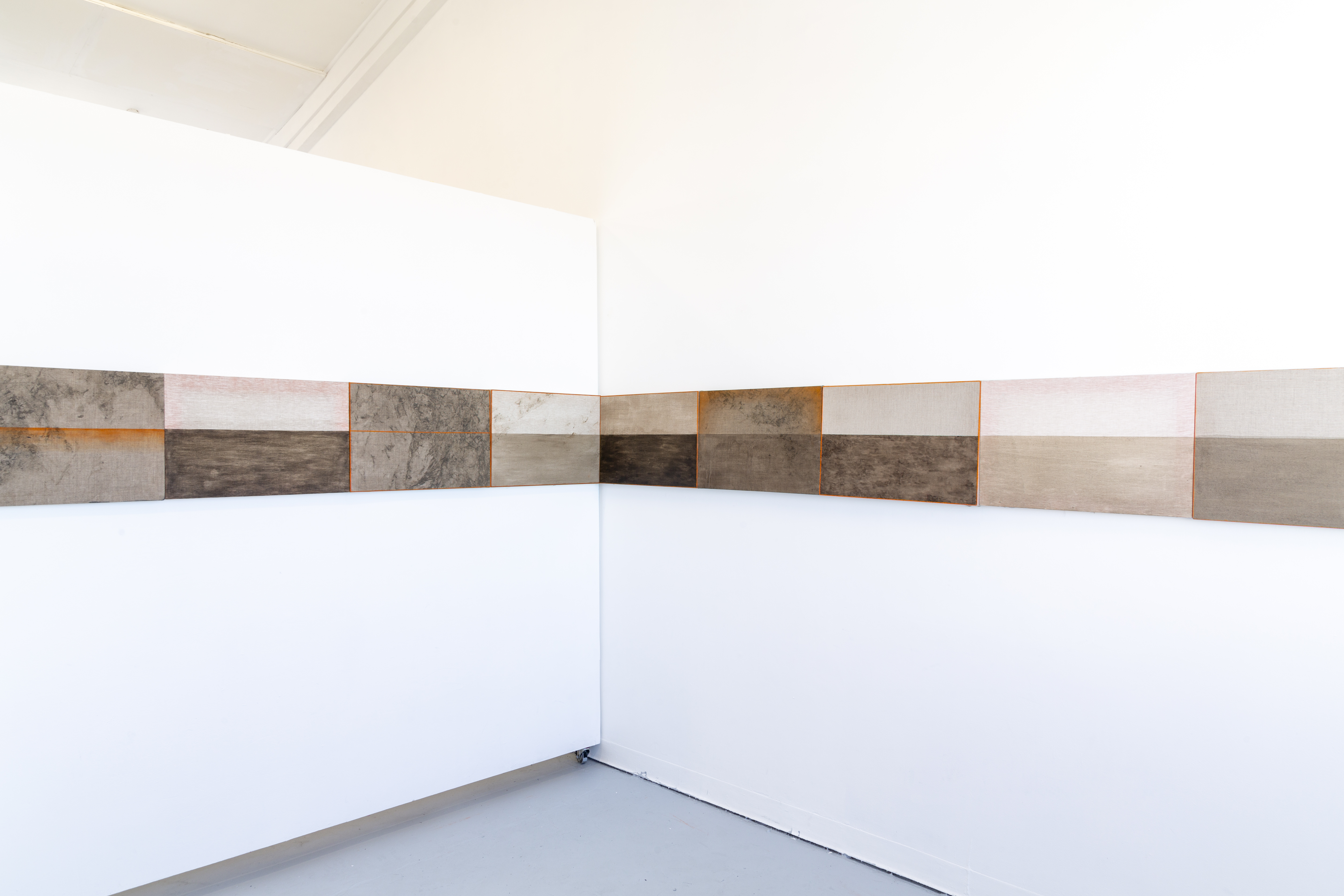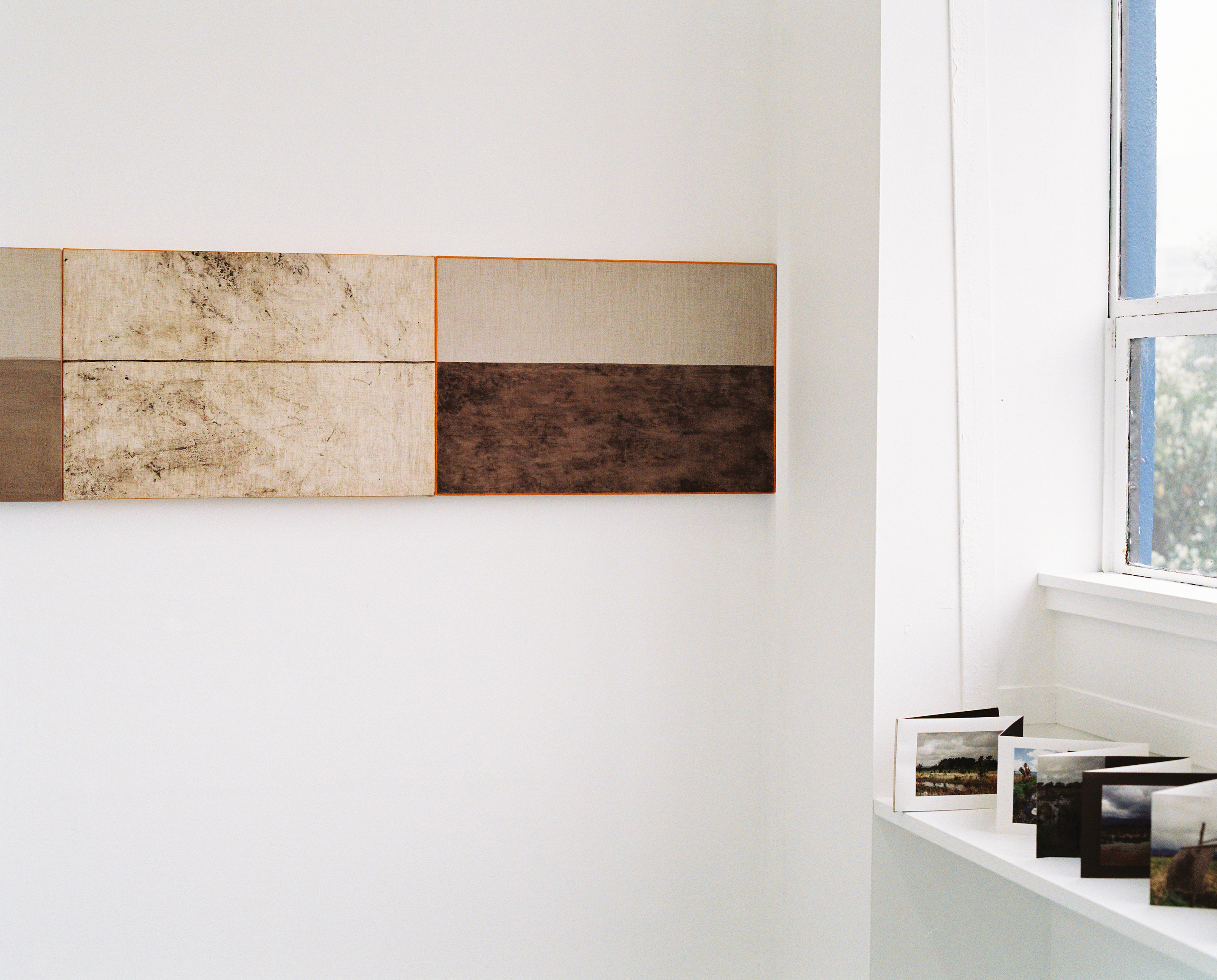Floodline
mud, whenua pigment watercolour and oil (Boggy Pond, Wairarapa Moana, harakeke seed oil), store-bought pastel and oil on 10 stretched linen and hemp canvases, 400x600mm each
I find myself standing in the heart of Boggy Pond, on the shores of Wairarapa Moana. My hair whips across my face as the southerly wind gusts across the plains, rustling the raupō reeds and sending their fluffy down drifting through the air. The tī kouka leaves sway wildly, and the calls of black swans echo between the gnarled, lifeless willow branches that protrude from the vibrant green and red azolla covering the murky water below. I become acutely aware of my presence in relation to the diverse life forms surrounding me. I am manuhiri, a visitor here.
Wairarapa Moana, a taonga, a gift from the atua, a revered tipuna. A place of mana and mauri, it has witnessed the hekenga/migration of many - Rangitāne, Ngāti Kahungunu, Ngāti Ira, Ngāi Tahu, Mauaūpoko and others.
Numerous kōrero and waiata weave tales of Wairarapa Moana’s creation and naming. It is said to be the freshwater eye of Te-Ika-a-Māui - Wellington Harbour being its saltwater counterpart. Kupe is attributed to naming the lake Wairarapa in one account, while in another, Haunui-ā-Nanaia christened it as he gazed upon the land from the Remutaka summit. The moana glistened in the sunlight, its reflection bringing tears to his eyes, and inspiring the name Wairarapa Moana - “sea of glistening waters.”
A vital source of kai and resources, Wairarapa Moana once teemed with inanga/whitebait, kōkopu, and tuna/eel. The lake used to double in size. When the rains came in autumn, the plains would flood, signalling heke tuna – the eel migration out to sea for breeding. This period was called hinurangi and enabled iwi to trade far outside the rohe. The sandspit at Lake Ōnoke has since been modified to control natural flooding, disrupting the seasonal tuna gathering. There have been many measures by governing bodies and farmers to control the lakes, rivers, and catchments in the Wairarapa. Seasonal fluctuations have been halted not only by opening Ōnoke Spit, but by building stopbanks, diverting rivers, installing floodgates, and draining wetlands. Since 1964, 5,500 hectares of lakes and wetlands have been drained. Invasive species compete with native species for food. Sewage, effluent, fertilizer, and sediment runoff have polluted waterways, and they are no longer safe for drinking or swimming, being considered “supertrophic” - nearly lifeless.
Land dealings around Wairarapa Moana have been marred with disputes. Attempting to resolve them, Ngāti Kahungunu ki Wairarapa gifted Wairarapa Moana to the Crown in 1896 as a tuku rangatira – a chiefly gift. However, the Crown failed on its promise to provide reserves of this gifted land for mana whenua. Instead, Ngāti Kahungunu was given land at Pouakani, Waikato. This loss of land has caused intergenerational suffering and led to multiple Treaty settlement claims.
In a recent Treaty settlement, the lake bed has been returned to iwi. A statutory board, composed of Ngāti Kahungunu ki Wairarapa, Rangitāne o Wairarapa, and the Crown (DOC, regional and district councils), now manages the lakes, reserves, and the broader catchment area. Its purpose is to act as kaitiaki for the benefit of current and future generations. Various groups, such as the Wairarapa Moana Wetlands Project, are engaged in the conservation and restoration of Wairarapa Moana and its waterways. Their mahi includes pest control of plants and animals, riparian planting, fencing to protect native species, species monitoring, working with farmers to mitigate nutrient and effluent runoff, and education and community outreach. These collaborative efforts underscore the importance of reciprocal relationships between communities and their environments. The health of our environments is intrinsically linked to our own. By embracing this connection, and fostering aroha and care for all beings, we can look to the future with hope.
Like a jewel, contained within the boundaries that separate it from pasture, this place shines brightly. It invites me in, always surprising me, always teaching me, becoming surrogate kin. Far away, on the opposite side of the world a wetland treasure cradles the lake that my ancestors fished from. Yet I stand here on this both contested and treasured land, the droplets of rain and sun rays simultaneously tickling my face, acknowledging those that came before, and those that continue to uphold the mana of this place.
Ngā mihi, Boggy Pond, thank you for your collaboration.
This work was exhibited as part of Massey University’s 2023 graduate show Exposure under the project title Glistening.
Wairarapa Moana, a taonga, a gift from the atua, a revered tipuna. A place of mana and mauri, it has witnessed the hekenga/migration of many - Rangitāne, Ngāti Kahungunu, Ngāti Ira, Ngāi Tahu, Mauaūpoko and others.
Numerous kōrero and waiata weave tales of Wairarapa Moana’s creation and naming. It is said to be the freshwater eye of Te-Ika-a-Māui - Wellington Harbour being its saltwater counterpart. Kupe is attributed to naming the lake Wairarapa in one account, while in another, Haunui-ā-Nanaia christened it as he gazed upon the land from the Remutaka summit. The moana glistened in the sunlight, its reflection bringing tears to his eyes, and inspiring the name Wairarapa Moana - “sea of glistening waters.”
A vital source of kai and resources, Wairarapa Moana once teemed with inanga/whitebait, kōkopu, and tuna/eel. The lake used to double in size. When the rains came in autumn, the plains would flood, signalling heke tuna – the eel migration out to sea for breeding. This period was called hinurangi and enabled iwi to trade far outside the rohe. The sandspit at Lake Ōnoke has since been modified to control natural flooding, disrupting the seasonal tuna gathering. There have been many measures by governing bodies and farmers to control the lakes, rivers, and catchments in the Wairarapa. Seasonal fluctuations have been halted not only by opening Ōnoke Spit, but by building stopbanks, diverting rivers, installing floodgates, and draining wetlands. Since 1964, 5,500 hectares of lakes and wetlands have been drained. Invasive species compete with native species for food. Sewage, effluent, fertilizer, and sediment runoff have polluted waterways, and they are no longer safe for drinking or swimming, being considered “supertrophic” - nearly lifeless.
Land dealings around Wairarapa Moana have been marred with disputes. Attempting to resolve them, Ngāti Kahungunu ki Wairarapa gifted Wairarapa Moana to the Crown in 1896 as a tuku rangatira – a chiefly gift. However, the Crown failed on its promise to provide reserves of this gifted land for mana whenua. Instead, Ngāti Kahungunu was given land at Pouakani, Waikato. This loss of land has caused intergenerational suffering and led to multiple Treaty settlement claims.
In a recent Treaty settlement, the lake bed has been returned to iwi. A statutory board, composed of Ngāti Kahungunu ki Wairarapa, Rangitāne o Wairarapa, and the Crown (DOC, regional and district councils), now manages the lakes, reserves, and the broader catchment area. Its purpose is to act as kaitiaki for the benefit of current and future generations. Various groups, such as the Wairarapa Moana Wetlands Project, are engaged in the conservation and restoration of Wairarapa Moana and its waterways. Their mahi includes pest control of plants and animals, riparian planting, fencing to protect native species, species monitoring, working with farmers to mitigate nutrient and effluent runoff, and education and community outreach. These collaborative efforts underscore the importance of reciprocal relationships between communities and their environments. The health of our environments is intrinsically linked to our own. By embracing this connection, and fostering aroha and care for all beings, we can look to the future with hope.
Like a jewel, contained within the boundaries that separate it from pasture, this place shines brightly. It invites me in, always surprising me, always teaching me, becoming surrogate kin. Far away, on the opposite side of the world a wetland treasure cradles the lake that my ancestors fished from. Yet I stand here on this both contested and treasured land, the droplets of rain and sun rays simultaneously tickling my face, acknowledging those that came before, and those that continue to uphold the mana of this place.
Ngā mihi, Boggy Pond, thank you for your collaboration.
This work was exhibited as part of Massey University’s 2023 graduate show Exposure under the project title Glistening.




